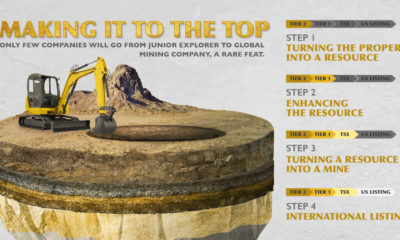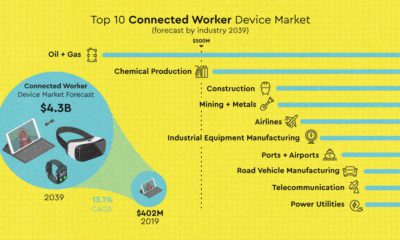Today’s infographic comes from GoldSpot Discoveries, and it shows that when this tech is applied to massive geological data sets, that there is growing potential to unlock the next wave of mineral discoveries.
Mineral Exploration: Fortunes Go to the Few
Discovering new sources of minerals, such as copper, gold, or even cobalt, can be notoriously difficult but also very rewarding. According to Goldspot, the chance of finding a new deposit is around 0.5%, with odds improving to 5% if exploration takes place near a known resource.
On the whole, mineral exploration has not been a winning prospect if you compare the total dollar spend and the actual value of the resulting discoveries.
Measuring Discovery Performance by Region (2005 to 2014)
Aside from the geographic insights, on the surface this data reveals that mineral exploration does not pay for itself. That said, there are still significant discoveries worth billions of dollars – it’s just the returns go inordinately to a few small players that make big finds.
Much of the money spent on exploration may not have produced the next great discovery, but you can be sure it created massive volumes of data that could be used for further refining of exploration models.
So, What is the Problem?
Every exploration failure or success produces geological insights. The mineral exploration process is the source of massive amounts of data in the form of soil samples, chip samples, geochemistry, drill results, and assay results. Each drill hole is a tiny snapshot into the processes that form the earth.
A single drill hole can create 200 megabytes of data and when there are many drill holes coupled with other types of information, an exploration project can produce terabytes of data. If you wanted to compare your one project to hundreds of others to find the best insights, the amount of data becomes dizzying.
All these data points are clues that can be used to find new mineral deposits, but to sort through them is too much for even an entire team of capable geologists.
Luckily, using today’s technology, this data can now be used to train computers to spot the areas showing similar patterns to past discoveries.
AI-Assistance
The true power of AI will be in its ability to empower technically trained professionals to make decisions in an increasingly complex and data-driven world.
Professor Ajay Agrawal, a noted academic in AI and founder of the University of Toronto’s Creative Destruction Lab, categorizes human activities into five categories:
He concludes that machines should do the first three and that humans – such as geologists, doctors, lawyers, investment bankers and others – should make the judgment calls and take the actions based on predictive capabilities of AI.
The mineral exploration industry presents a good example of how AI and big data can help technical professionals make discoveries faster, with less money, using a wide variety of data inputs created.
Opportunity Generator and the AI-friendly Future
AI can take the large amounts of data from many different projects in order to spot the right opportunities to further explore, building on decades of geological data from projects around the world. The right technology can help reduce the risk inherent in exploration and lead to more mineral discoveries on budget, rewarding those that deployed their data most effectively. Companies that are able to harness this power will tip the scales in their favor. As a result, mineral exploration is no longer so much an art of interpretation – but instead, it becomes closer to a pure science, giving geologists a whole-field perspective of all the data. on Did you know that nearly one-fifth of all the gold ever mined is held by central banks? Besides investors and jewelry consumers, central banks are a major source of gold demand. In fact, in 2022, central banks snapped up gold at the fastest pace since 1967. However, the record gold purchases of 2022 are in stark contrast to the 1990s and early 2000s, when central banks were net sellers of gold. The above infographic uses data from the World Gold Council to show 30 years of central bank gold demand, highlighting how official attitudes toward gold have changed in the last 30 years.
Why Do Central Banks Buy Gold?
Gold plays an important role in the financial reserves of numerous nations. Here are three of the reasons why central banks hold gold:
Balancing foreign exchange reserves Central banks have long held gold as part of their reserves to manage risk from currency holdings and to promote stability during economic turmoil. Hedging against fiat currencies Gold offers a hedge against the eroding purchasing power of currencies (mainly the U.S. dollar) due to inflation. Diversifying portfolios Gold has an inverse correlation with the U.S. dollar. When the dollar falls in value, gold prices tend to rise, protecting central banks from volatility. The Switch from Selling to Buying In the 1990s and early 2000s, central banks were net sellers of gold. There were several reasons behind the selling, including good macroeconomic conditions and a downward trend in gold prices. Due to strong economic growth, gold’s safe-haven properties were less valuable, and low returns made it unattractive as an investment. Central bank attitudes toward gold started changing following the 1997 Asian financial crisis and then later, the 2007–08 financial crisis. Since 2010, central banks have been net buyers of gold on an annual basis. Here’s a look at the 10 largest official buyers of gold from the end of 1999 to end of 2021: Rank CountryAmount of Gold Bought (tonnes)% of All Buying #1🇷🇺 Russia 1,88828% #2🇨🇳 China 1,55223% #3🇹🇷 Türkiye 5418% #4🇮🇳 India 3956% #5🇰🇿 Kazakhstan 3455% #6🇺🇿 Uzbekistan 3115% #7🇸🇦 Saudi Arabia 1803% #8🇹🇭 Thailand 1682% #9🇵🇱 Poland1282% #10🇲🇽 Mexico 1152% Total5,62384% Source: IMF The top 10 official buyers of gold between end-1999 and end-2021 represent 84% of all the gold bought by central banks during this period. Russia and China—arguably the United States’ top geopolitical rivals—have been the largest gold buyers over the last two decades. Russia, in particular, accelerated its gold purchases after being hit by Western sanctions following its annexation of Crimea in 2014. Interestingly, the majority of nations on the above list are emerging economies. These countries have likely been stockpiling gold to hedge against financial and geopolitical risks affecting currencies, primarily the U.S. dollar. Meanwhile, European nations including Switzerland, France, Netherlands, and the UK were the largest sellers of gold between 1999 and 2021, under the Central Bank Gold Agreement (CBGA) framework. Which Central Banks Bought Gold in 2022? In 2022, central banks bought a record 1,136 tonnes of gold, worth around $70 billion. Country2022 Gold Purchases (tonnes)% of Total 🇹🇷 Türkiye14813% 🇨🇳 China 625% 🇪🇬 Egypt 474% 🇶🇦 Qatar333% 🇮🇶 Iraq 343% 🇮🇳 India 333% 🇦🇪 UAE 252% 🇰🇬 Kyrgyzstan 61% 🇹🇯 Tajikistan 40.4% 🇪🇨 Ecuador 30.3% 🌍 Unreported 74165% Total1,136100% Türkiye, experiencing 86% year-over-year inflation as of October 2022, was the largest buyer, adding 148 tonnes to its reserves. China continued its gold-buying spree with 62 tonnes added in the months of November and December, amid rising geopolitical tensions with the United States. Overall, emerging markets continued the trend that started in the 2000s, accounting for the bulk of gold purchases. Meanwhile, a significant two-thirds, or 741 tonnes of official gold purchases were unreported in 2022. According to analysts, unreported gold purchases are likely to have come from countries like China and Russia, who are looking to de-dollarize global trade to circumvent Western sanctions.
There were several reasons behind the selling, including good macroeconomic conditions and a downward trend in gold prices. Due to strong economic growth, gold’s safe-haven properties were less valuable, and low returns made it unattractive as an investment.
Central bank attitudes toward gold started changing following the 1997 Asian financial crisis and then later, the 2007–08 financial crisis. Since 2010, central banks have been net buyers of gold on an annual basis.
Here’s a look at the 10 largest official buyers of gold from the end of 1999 to end of 2021:
Source: IMF
The top 10 official buyers of gold between end-1999 and end-2021 represent 84% of all the gold bought by central banks during this period.
Russia and China—arguably the United States’ top geopolitical rivals—have been the largest gold buyers over the last two decades. Russia, in particular, accelerated its gold purchases after being hit by Western sanctions following its annexation of Crimea in 2014.
Interestingly, the majority of nations on the above list are emerging economies. These countries have likely been stockpiling gold to hedge against financial and geopolitical risks affecting currencies, primarily the U.S. dollar.
Meanwhile, European nations including Switzerland, France, Netherlands, and the UK were the largest sellers of gold between 1999 and 2021, under the Central Bank Gold Agreement (CBGA) framework.
Which Central Banks Bought Gold in 2022?
In 2022, central banks bought a record 1,136 tonnes of gold, worth around $70 billion. Türkiye, experiencing 86% year-over-year inflation as of October 2022, was the largest buyer, adding 148 tonnes to its reserves. China continued its gold-buying spree with 62 tonnes added in the months of November and December, amid rising geopolitical tensions with the United States. Overall, emerging markets continued the trend that started in the 2000s, accounting for the bulk of gold purchases. Meanwhile, a significant two-thirds, or 741 tonnes of official gold purchases were unreported in 2022. According to analysts, unreported gold purchases are likely to have come from countries like China and Russia, who are looking to de-dollarize global trade to circumvent Western sanctions.












